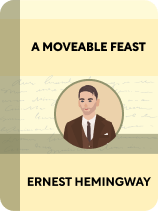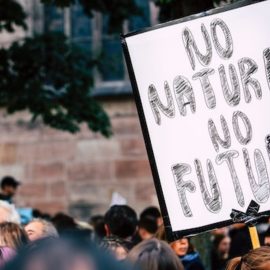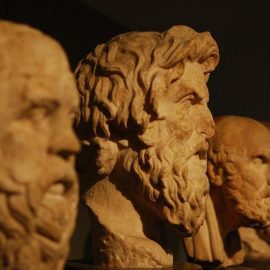

This article is an excerpt from the Shortform book guide to "A Moveable Feast" by Ernest Hemingway. Shortform has the world's best summaries and analyses of books you should be reading.
Like this article? Sign up for a free trial here .
What happens in Ernest Hemingway’s A Moveable Feast? What was it like to be a writer in Paris in the 1920s?
In Ernest Hemingway’s A Moveable Feast, Hemingway describes what it was like to live in Paris in the early 1920s as a writer. He talks about his relationships with other writers, the struggles of poverty and hunger, and what it was like to be part of the “Lost Generation.”
Here’s an overview of Hemingway’s vignettes.
A Moveable Feast: Overview
Ernest Hemingway’s A Moveable Feast is a collection of vignettes of his time in Paris between 1921 and 1926. It tells the story of a young man of the “lost generation” of modernist writers and artists living and working in the interwar period. It brings us face to face with the literary giants like James Joyce, Ezra Pound, T.S. Eliot, and F. Scott Fitzgerald, as well as famous places like bookstore Shakespeare and Company and its proprietor Sylvia Beach, all of whom influenced Hemingway’s development as a writer.
Early Days in Paris
Paris seemed bleak when the winter rains came, and the small shops selling newspapers or herbs closed their doors. Hemingway lived in the hotel where French poet Paul Verlaine died, and it got cold in his apartment, which was somewhere between six and eight stories up, when the rains began. Hemingway often walked around the city, down the Boulevard St.-Michel and the Boulevard St.-Germain, past the Cluny Museum, and found a café on the Place St.-Michel where he would write. When the rains dissipated and the weather turned cold and clear, Paris became a different, more energized city. The bare trees in the Luxembourg Garden looked like sculptures. Even the stairs up to his apartment in the hotel didn’t feel so bothersome.
Hemingway usually wrote in his apartment, and he didn’t stop until he knew where his story was going, so he had something to write about the next day. However, occasionally he’d have writer’s block in trying to start something new, so he’d sit at the fire and just try to write one “true sentence.” Often, this took the form of a simple declarative statement that could begin a story. After writing a “true sentence,” he didn’t have any trouble continuing a story from there.
He also learned to stop thinking about writing after he’d quit for the day. This way, he could really listen to people and things around him for material he could use in his stories the next day. He felt good walking around Paris after a successful writing session.
Hemingway walked around the Luxembourg Gardens and viewed Impressionist works at the Musée du Luxembourg. Afterward, he sometimes visited novelist and poet Gertrude Stein at 27 rue de Fleurus, where she lived with a female companion. Stein was large but not particularly tall and had nice eyes as well as a German/Jewish face. Hemingway and his wife Hadley, whom he married in 1921, often visited the two women together, and they visited Hemingway’s place in turn.
Stein told Hemingway that she liked his stories, but while his writing was new and unique, he wasn’t good enough yet to be published in any big newspapers or magazines. Also, their sexual content made his stories unpublishable. Hemingway responded that he was trying to authentically reflect the way people talked, which Stein said was pointless if he couldn’t sell his work. Stein also contended Hemingway was part of a “lost generation”—those who had fought in the war and were now drinking themselves to death. This made Hemingway think about Stein’s own shortcomings on his walk home, and he wondered whether he was part of a lost generation or whether she was lost herself. He realized that all generations were lost in their own way—each affected by different things while growing up.
Life Around the Seine
Hemingway was too poor to buy books, so he rented them from Sylvia Beach at the bookstore Shakespeare and Company. Even though Hemingway didn’t have much money when he first visited Shakespeare and Company, Beach said he could rent books and pay when he was able. She also invited him and Hadley to dinner.
Hemingway went home with many books and told Hadley about his agreement with Beach. She said he was lucky to have found Shakespeare and Company and asked whether he could rent some Henry James books for her. Happy with the arrangement, they began to dream about a better, more stable life in Paris.
On clear winter days, many people walked along the banks of the Seine, which cuts through the middle of Paris. Hemingway walked to the Ile St.-Louis in the middle of the Seine, and then to the Ile de la Cité next to the Ile St.-Louis. At the bookstores in this neighborhood, he sometimes found just-published American books that were inexpensive. A proprietor explained that books in English were often bound cheaply, while French books were better made. Since the proprietors often didn’t speak English, they assumed all of the English books were cheap, and they often just threw them away.
Hemingway often walked to the edge of the Ile de la Cité and watched fishermen use long poles to catch fish. Open-air restaurants fried the fish whole, and they were delicious. When they had money, Hemingway and Hadley ate fish at La Pêche Miraculeuse (the miraculous peach).
Spring in Paris
With spring’s arrival, all problems evaporated. Hemingway wrote in the early morning before the shops opened. A goatherd came down the street and a woman walked outside and purchased goat’s milk. Hemingway never had much money, but he and Hadley didn’t think of themselves as poor—rather, they considered themselves intellectually superior and didn’t trust the rich. They were still able to eat and drink well, but cheaply, in Paris. Often, Hemingway and Hadley went to the races. They had some successes betting on horses, but they were still poor, and Hemingway was often hungry. However, he believed this cleared his mind and allowed him to focus on his writing.
Modernist Novelists and Poets
Sometimes, Hemingway wrote so intently that he’d feel himself inside the scene he was creating. Then, someone would find him at whatever café he was writing in and interrupt the trance. Hemingway often got angry, cursing at whoever happened to recognize him and say hello.
Hemingway honed his craft amid an ex-pat community that included many modernist writers with whom he was friends, including Ezra Pound. Pound and his wife Dorothy had a studio on Notre-Dame-des-Champs where they displayed art from Pound’s friends. While Hemingway didn’t like the art, he admired Pound for supporting his friends’ work. One day, Pound asked Hemingway to teach him to box, and Hemingway tried his best, as English writer Wyndham Lewis looked on. Afterward, they had a drink; to Hemingway, Lewis looked like a nasty man with eyes of an “unsuccessful rapist.”
Pound, though, was extremely kind and helpful. He had friends in all kinds of art-related fields, whom he tried to help along. He was particularly concerned that since the poet T.S. Eliot was working at a bank, he didn’t have enough time to write.
Pound had a charitable initiative, which he called Bel Esprit, that aimed to raise enough money for Eliot to become a full-time writer. Natalie Barney, a rich American, became the patron. Hemingway was also enthusiastic about the plan and helped to find money. After Eliot published The Waste Land, he became better known and was able to give up his bank job, thanks to the Bel Esprit campaign and to the fact that he found his own patrons.
Hemingway met poet Ernest Walsh at Ezra Pound’s studio. Intense and very Irish, Walsh arrived at the studio with two American women he’d met on a ship returning from the U.S. The women were boasting about how much Walsh was paid for his poetry. Hemingway noticed that Walsh looked visibly ill, or “marked for death” (doomed like a character in a movie).
Walsh took Hemingway out to a very expensive lunch, where they discussed a rumored $1,000 prize to be given by The Dial, a literary magazine that Walsh helped edit. After they had a few drinks, Walsh said Hemingway was going to receive the prize. The more Walsh talked, though, the more convinced Hemingway became that he was being conned. Their conversation drifted from the talents of James Joyce to Hemingway himself. In discussing Joyce’s poor eyesight, Hemingway noted that everyone had some sort of health problem. Walsh responded that Hemingway didn’t seem to have any health issues. Rather than being “marked for death,” Walsh said, Hemingway appeared to be “marked for life.”
Walsh became increasingly sick; eventually, he had hemorrhages and had to leave Paris. Before leaving, he asked Hemingway to take charge of The Dial’s printing in Paris, which Hemingway did happily. He had enjoyed Walsh’s company and respected Walsh’s co-editor despite feeling conned.
Years later, Hemingway was discussing Walsh with James Joyce, who asked if Walsh had promised Hemingway the award. Hemingway said yes, and Joyce said Walsh had promised it to him as well. Hemingway told Joyce about the women in Pound’s studio bragging about Walsh’s money, which Joyce found amusing.
Scott and Zelda Fitzgerald
Hemingway first met F. Scott Fitzgerald in a cafe. Fitzgerald was accompanied by Dunc Chaplin, who was a pitcher for the Princeton Baseball Team. Fitzgerald had a boyish face with wavy hair and a high forehead. His eyes were friendly and his mouth looked like a woman’s. Fitzgerald praised Hemingway’s work to Chaplin.
As they drank, Fitzgerald began asking Hemingway questions about his personal life, like whether he had sex with his wife before they were married. Hemingway said he didn’t remember, but Fitzgerald continued to press him. Suddenly, Fitzgerald’s face started to tighten, and he looked very ill. Hemingway was alarmed and said they should get him to a doctor, but Chaplin said Fitzgerald always looked this way when he drank. The next time Hemingway saw him, Fitzgerald acted as though everything were normal and alcohol didn’t affect him strangely, although he appeared to be remembering a different night than the one he had spent with Hemingway.
Fitzgerald discussed the faults of his earlier books with Hemingway—his insistence that they were no good led Hemingway to believe that his latest book, The Great Gatsby, was very good. Fitzgerald said the book wasn’t selling, but he had heard that there were good reviews. He was happy with the book but upset that it wasn’t selling well. To make his stories commercially viable, Fitzgerald often revised them. Hemingway was horrified by this and called it whoring. He wanted Fitzgerald to simply focus on writing the best stories that he could.
Soon after, Fitzgerald asked Hemingway to accompany him to Lyon to pick up a car he’d left there. On this trip, Hemingway realized that Fitzgerald couldn’t handle his liquor. When they returned, Hemingway and Hadley went to lunch with Fitzgerald and his wife Zelda, and it was clear to Hemingway that their relationship was destructive. Zelda and Scott argued about drinking—Zelda was hungover and was annoyed that Scott was abstaining from alcohol to focus on his writing. She was outwardly pleasant but seemed bothered at the lunch, which was not very tasty. But heir daughter was cute and spoke in a cockney English accent because she had a nanny who did so.
Hemingway realized that Zelda was jealous of Scott’s writing—she tried to get him to drink so he couldn’t write; he tried to abstain so that he could. Scott was also jealous of Zelda, especially her past relationships and the parties that she went to. They both got drunk so often that Scott sometimes barely wrote at all.
Fitzgerald blamed Paris for his struggles to write and wanted Hemingway and Hadley to go out to the Riviera with them in the summer, as he thought this could fix his writing funk. Fitzgerald was still frustrated that Gatsby wasn’t selling well, so he concentrated on writing marketable stories, while Hemingway tried to persuade him to write more novels like Gatsby. Fitzgerald remained mostly cheerful though, and even when he wasn’t, he could poke some fun at himself.
Over the summer, Hemingway traveled to Spain with Hadley, and he started a novel there. (Shortform note: The novel was The Sun Also Rises, published in 1926.)
When he returned to Paris, he found that Fitzgerald had gone with his family to Cap d’Antibes on the Riviera (a peninsula in the South of France near Nice) and had only become more of a drunk. Fitzgerald stopped caring that he wasn’t working and started getting drunk during the day. He occasionally was sober and writing, but when he was drunk, he found Hemingway and tried to get him to stop his own writing. However, Fitzgerald remained an intensely loyal friend when he was sober.
While Hemingway was working in Austria, Fitzgerald invited Hemingway and Hadley to stay with them in the Pyrenees, where Fitzgerald promised there wouldn’t be too much drinking and they could all write. Hemingway agreed and actually found it to be a nice place to write. Fitzgerald and Zelda both looked healthy—he had some money coming in, and they didn’t drink too heavily.
Nonetheless, Fitzgerald didn’t write anything good again until he learned from doctors that Zelda was mentally ill. (Shortform note: Zelda was diagnosed with schizophrenia in April of 1930 and institutionalized.)
Paris Endures
Hemingway eventually moved from Paris to Austria in the winters because he and Hadley had a child who couldn’t take the cold. On one of these visits, he met a woman, Pauline Pfeiffer, with whom he began an affair. He went to New York to deal with publishing The Sun Also Rises, then returned to Paris and stayed with her. When he went back to Hadley in Schruns, he thought he still loved only her, but when they returned to Paris, he started the affair again. For Hemingway, Paris was an important anchor—it changed while he changed, but it was and would always be Paris. He believed it lived in different forms in the memories of people who spent time there. A Moveable Feast reflects Hemingway’s memories of Paris when he was young, poor, and happy.

———End of Preview———
Like what you just read? Read the rest of the world's best book summary and analysis of Ernest Hemingway's "A Moveable Feast" at Shortform .
Here's what you'll find in our full A Moveable Feast summary :
- Ernest Hemingway's autobiography about his life in Paris between 1921 and 1926
- How Hemingway knew so many other great authors of the time
- Why F. Scott Fitzgerald was a toxic yet valuable friend to Hemingway






